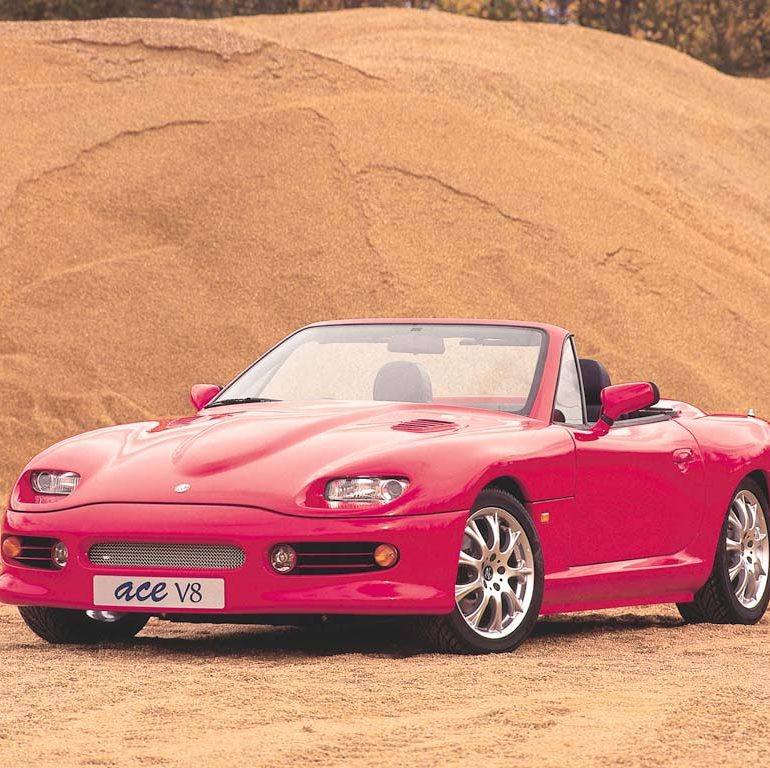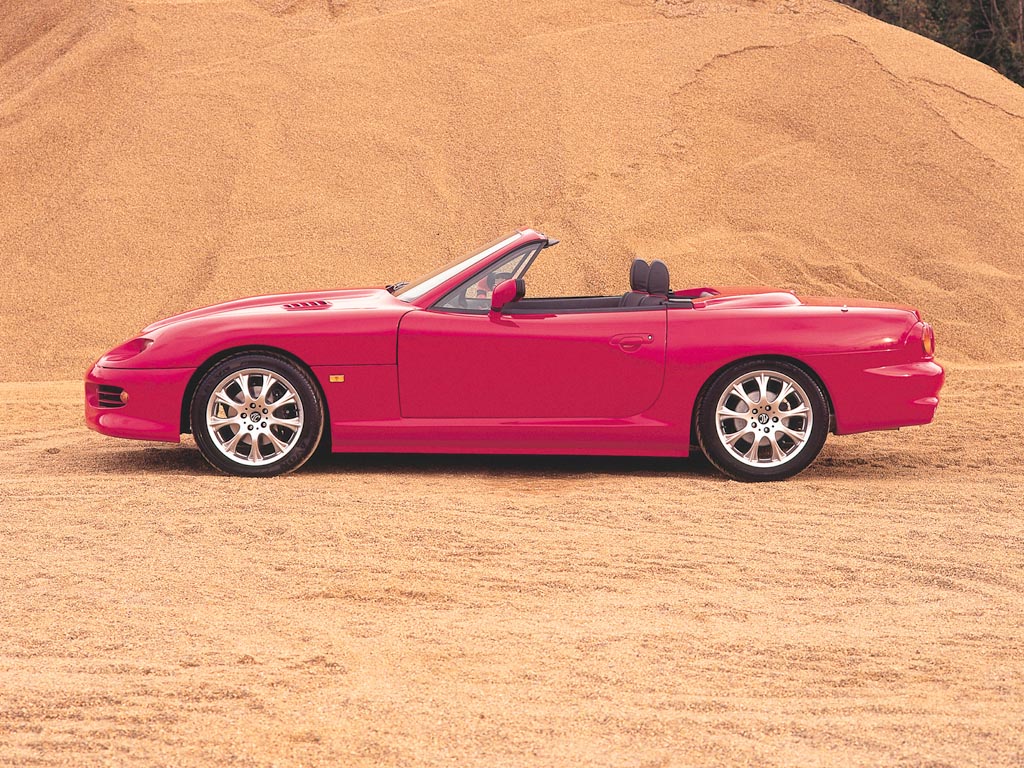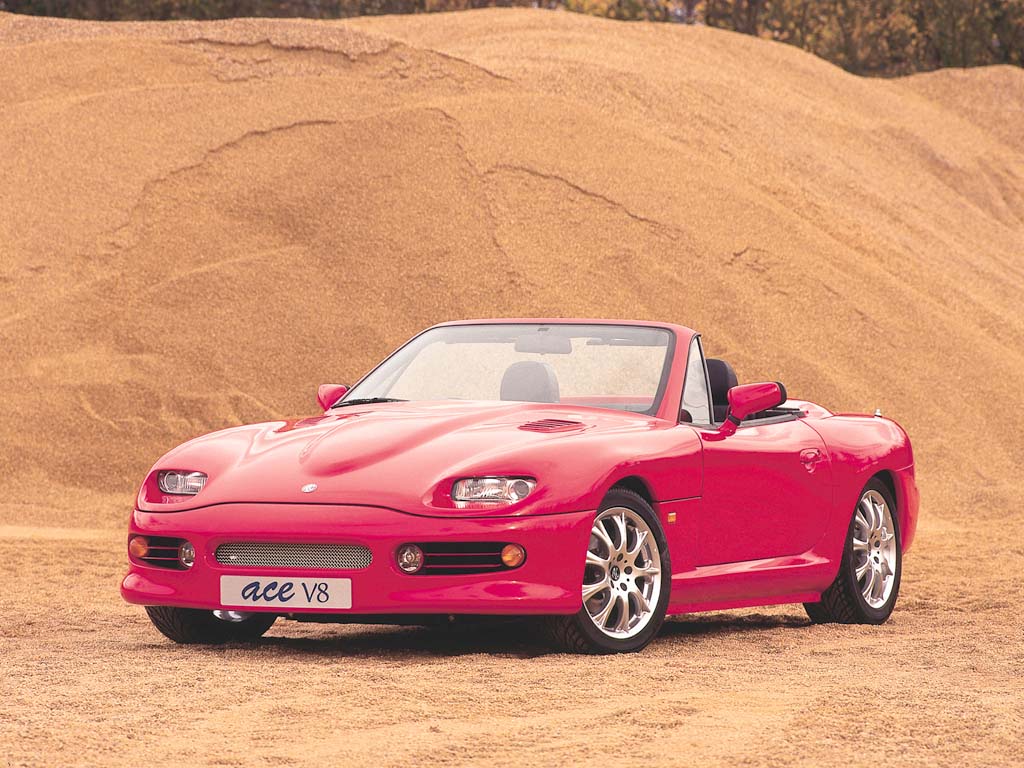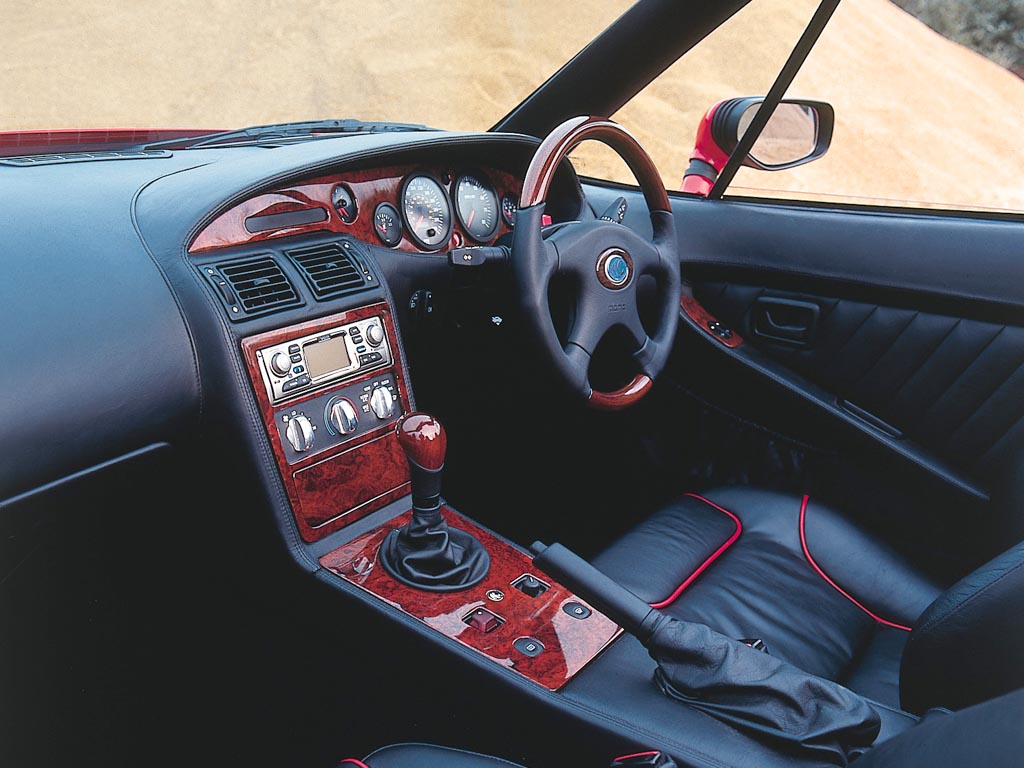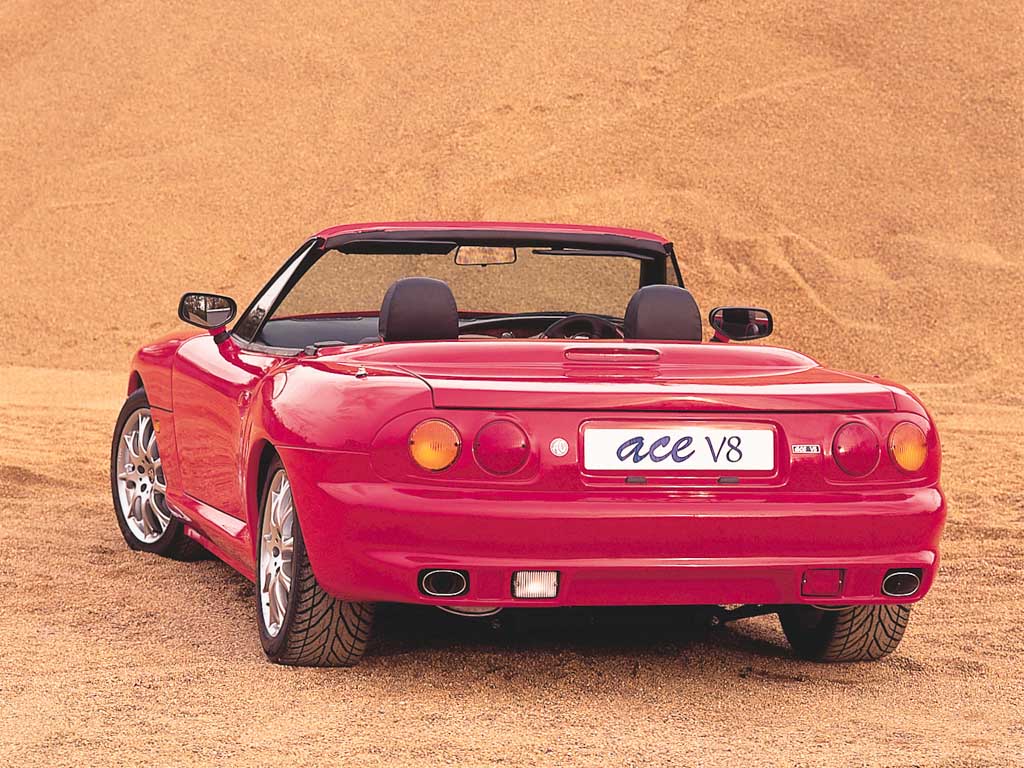1998→2000 AC Ace
In 1986, Brian Angliss acquired the historic AC nameplate and used his expertise from running Autokraft to relaunch a modern AC Ace. With considerable development time and funds the result was a new roadster that used American power in sleek British chassis and body. It was built in cooperation with Ford of Europe who owned nearly 51% of the company.
The long road to production included an initial 2+2 prototype coupe that was shown at the 1986 British Motor Show that was never put into production. This 2+2, 4WD Coupe was designed in part by Ford before they sold their entire interest in the company to Angliss.
For the second car, Angliss hired a multitude of talent including Len Bailey to design an all-new car and IAD to style the body. The result was a showcar known as the Brooklands that outlined the basic specification for the upcoming production car. The chassis was designed by Bailey to be a steel monocoque with aluminum-alloy panels. This first showcar again had 4WD and used a Ford SHO V6, neither of which would make final production.
In the end, Angliss opted for Ford’s High Output 5.0-liter engine which was much more suitable given the company’s history. Furthermore the driveline was a basic RWD setup and the front headlights were fixed in place.
At great personal expense to Angliss, production began in 1993, but by 1996 the company was bankrupt. Alan Lubinsky of Pride Automotive tried to save the company by offering a supercharged variant and even twin-turbo Lotus power, but neither could save the operation. In the end 50 cars were produced.
Company Release by AC Car Group Limited.
The Ace, a graceful, high performance, all metal two seater which is designed to compete head on with the products of Jaguar, Aston Martin, Mercedes and Porsche, has had one of the longest gestation periods of any car at the show. Conceived and initially put into limited pre-production some years ago by AC’s then owners, the Ace was completely re-engineered by AC Car Group after it acquired the business in late 1996. A revised prototype was shown at the London Motor Show in 1997 but this year’s Birmingham show sees the Ace in final production guise.
Designed and developed entirely in the UK, the Ace reflects its AC pedigree with a unique combination of bespoke bodywork in the English tradition and a large 302 cu in V8 engine.
The new Ace features a distinctive pressed aluminium bodyshell and is available in three variants costing from under $70,000 to almost $80,000. There is a soft top convertible model with 240bhp 5.0 litre V8 engine, manual with a 32 valve quadcam engine developing 320bhp and supercharged 320 bhp 5.0 litre.
The car, which is being assembled for AC in Coventry, is capable of electrifying performance – up to 0 to 60 mph in 5.7 seconds and a top speed limited to 155 mph. Ace owners are offered a full specification car with powered hood and lift-off hardtop, full hide interior air, conditioning and a host of other advanced features, including Philips latest in-car entertainment centre which incorporates a satellite navigation system.
AC is Britain’s longest surviving automotive manufacturer and employs more than 50 people at its headquarters at Brooklands in Surrey.
The Ace started life in the 1980s when the then AC company recognised that it needed to broaden its model range. Several prototypes were developed and, many millions of pounds later, the Ace was shown at a number of motor shows in 1994. In reality much engineering work had not been properly completed and, although the car was greeted with rave reviews in the motoring media at the time, lack of proper production plans meant that it never went into full manufacture. AC Cars Ltd collapsed in March 1996.
When businessman Alan Lubinsky formed AC Car Group Ltd in December 1996 he quickly recognised that significant engineering work was still required to take the Ace to a final, productionised form – a job which fell to Jan-Erik Jansson, then AC’s newly-appointed General Manager. Jan-Erik, formerly of Volvo, comments: Bringing the Ace to a position where it can be made economically and to the highest quality levels has been much more of a challenge than any of us first realised. However the fundamental design principles of the original car – the aluminium body and stainless steel understructure – were sound despite being compromised by engineering changes made over a number of years. Today’s production version has been refined to the point where it can be made easily while retaining the designs unique styling and dynamic characteristics
Features of the 1998 ACE
Understructure – still in stainless steel due to its excellent mechanical properties, but 20% lighter. Simplified design harks back to original concept. Number of welds halved, ground clearance and structural integrity improved and more space for occupants.
Chassis – suspension geometry modified, front and rear subframes stiffened but lightened, 17in wheels with Yokohama tyres specified.
Body – restyled bonnet with no power bulge; new rectangular headlights; new front grille with mesh effect; although mainly made of aluminium, carbon fibre is used in certain key components; fuel tank capacity increased to 90 litres.
Weight – reduced by 120 kg.
Powertrain – three engine options:
*5.0 litre 240 bhp V8 fuel injected engine with automatic transmission mated to a new BTR limited slip differential;
*4.6 litre 320 bhp V8 32-valve fuel injected quadcam engine mated to a Borg Warner 5-speed manual gear box and new BTR hydraulic limited slip differential;
*5.0 litre 320 hp V8 supercharged engine fitted with a Borg Warner 5-speed manual gearbox and a new BTR hydraulic limited slip differential.
Interior – new dashboard and centre console; new instruments, switches and steering wheel, new leather door and other trim and new motorised leather seats.
Story by Richard Owen
In Detail
| type | Series Production Car |
| production years | 1998 – 2000 |
| built at | Coventry, England |
| body stylist | IAD |
| engineers | Len Bailey |
| production | 50 |
| price $ | $ 117,599 |
| price £/td> | £49.995 |
| engine | Supercharged V8 |
| position | Front Longitudinal |
| aspiration | Supercharged |
| block material | Cast Iron w/Aluminum Cylinder Head |
| valvetrain | OHV |
| fuel feed | Electronic Fuel Injection |
| displacement | 4942 cc / 301.58 in³ |
| bore | 101.6 mm / 4.0 in |
| stroke | 76.2 mm / 3.0 in |
| compression | 9.0:1 |
| power | 238.6 kw / 320.0 bhp @ 5700 rpm |
| specific output | 64.75 bhp per litre |
| bhp/weight | 220.23 bhp per tonne |
| torque | 521.99 nm / 385.0 ft lbs @ 3500 rpm |
| body / frame | Aluminum Body over Aluminum & Composite Bosy over Stainless Steel Monocoque Chassis |
| driven wheels | RWD w/BTR Hydratrak Hydraulic Slip Differential |
| front tires | 235/45ZR17 |
| rear tires | 255/40ZR17 |
| front brakes | Vented Discs w/ABS |
| rear brakes | Vented Discs w/ABS |
| front wheels | F 43.2 x 20.3 cm / 17.0 x 8.0 in |
| rear wheels | R 43.2 x 20.3 cm / 17.0 x 8.0 in |
| steering | Rack & Pinion w/Variable Power Assist |
| f suspension | Unequal Wishbones w/Coil Springs, Telescopic Dampers |
| r suspension | Unequal Wishbones w/Coil Springs, Twin Telescopic Dampers |
| curb weight | 1453 kg / 3200 lbs |
| wheelbase | 2472 mm / 97.3 in |
| front track | 1590 mm / 62.6 in |
| rear track | 1570 mm / 61.8 in |
| length | 4420 mm / 174.0 in |
| width | 1870 mm / 73.6 in |
| height | 1300 mm / 51.2 in |
| transmission | Borg Warner T50D 5-Speed Manual |
| gear ratios | 3.35:1, 1.93:1, 1.29:1, 1.00:1, 0.68:1 |
| final drive | 3.23:1 |
| top speed | ~249.4 kph / 155.0 mph |
| 0 – 60 mph | ~5.5 seconds |
| 0 – 100 mph | ~16.0 seconds |
| fuel econ epa | 10.23 L/100 km or 23 mpg-us |


